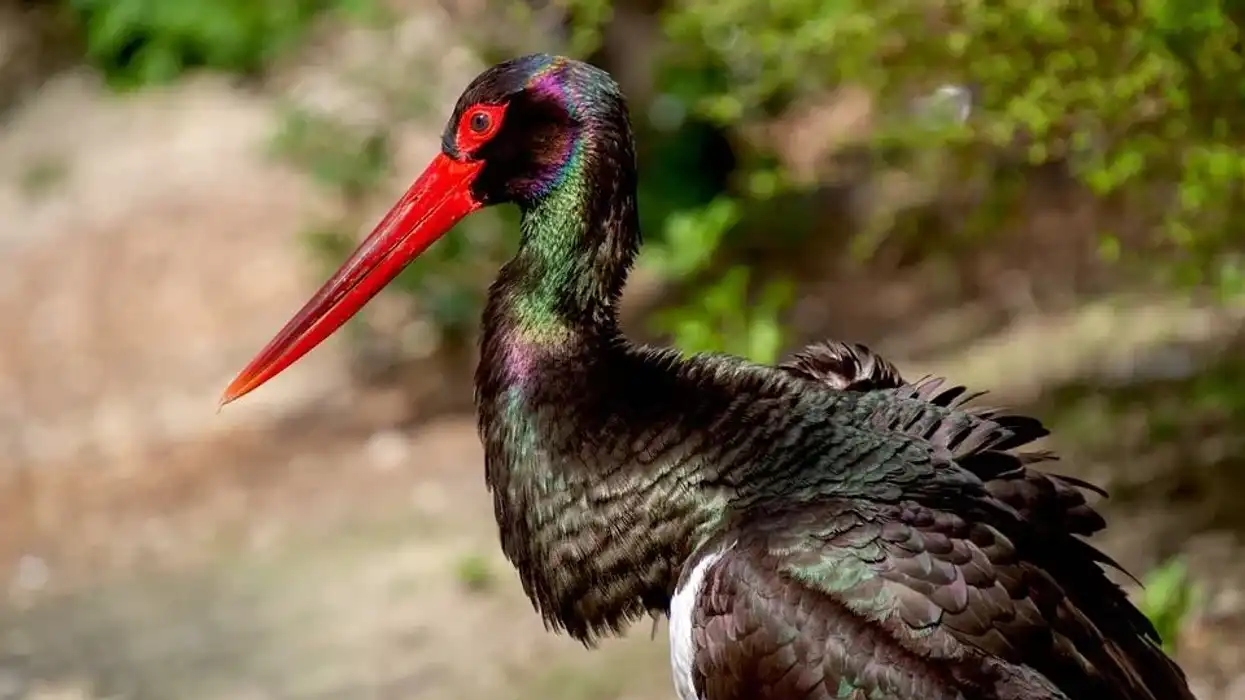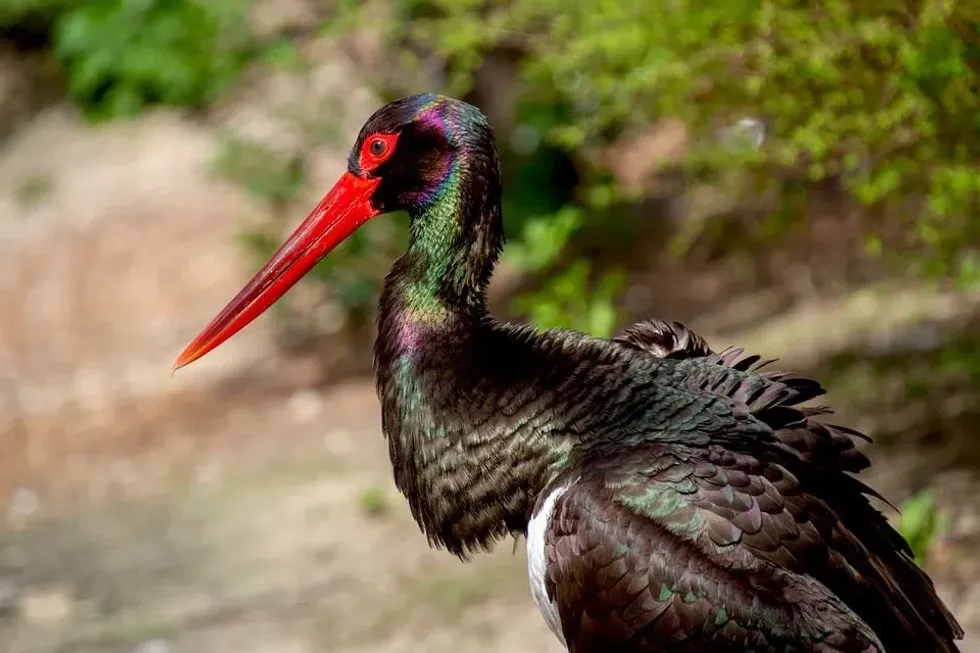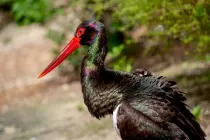Fun Black Stork Facts For Kids

The black stork (Ciconia nigra) is a beautiful, majestic bird with long straight legs, a sharp red bill, large wings, and shimmery necks. They are close relatives of the white storks.
When you first see this stork, the most striking feature is its scarlet red bill. Upon spotting this bird for the first time in Frankfurt, English naturalist Francis Willughby gave this bird its scientific name, Ciconia nigra.
This name comes from the Latin terms ‘nigra’, which translates to ‘black’, and ‘ciconia’, meaning ‘the stork bird’.
Europe, South Africa, Asia, and parts of tropical Africa- you will find black storks widespread across these continents, and they choose these regions for migration too. These birds are widespread, however, spotting them on populated lands might be difficult as they are super shy!
Enjoying our article about the black stork? We are sure you would love reading our pages on the wood stork and the black-necked stork.
Black Stork Interesting Facts
What type of animal is a black stork?
A black stork is a type of bird.
What class of animal does a black stork belong to?
This bird with long legs comes under the class of Aves, under the Ciconiidae family.
How many black storks are there in the world?
There are about 32,000 to 44,000 individuals of this species currently surviving in the world.
Where does a black stork live?
Black storks prefer living in forests, mountains, and hills that have a good water source nearby.
What is a black stork's habitat?
As their diet primarily includes fishes and other amphibians, these tall creatures usually live near rivers, ponds, lakes, marshy regions, or swampy areas. During the mating season, black storks prefer living in high trees in well-vegetated regions.
Their nests are usually built in deciduous forests, but they also choose coniferous forests for a good home. They are also found to make nests on mountains and hills near good water sources. They prefer staying away from humans.
Who do black storks live with?
These storks usually live either alone or either in pairs, avoiding contact with humans. However, during migration to a long-distance destination, these birds come in flocks that include about 100 other storks.
How long does a black stork live?
These Ciconiidae family members can live up to 18 years on their own in the wild. However, there are records of these birds living up to 36 years in captivity.
How do they reproduce?
The breeding season of these storks is usually in April and May in the Northern Hemisphere, however, it is between September to March that these birds mate in South Africa. Just like the white stork, the black stork pairs usually perform special aerial dances to impress each other and communicate with mutual bill clattering.
The mating ritual usually takes place in a dense forest.
The stork nests are large, usually built with twigs, large branches, and sticks. These nests are built at great elevations, usually at heights of 13-82 ft (4-25 m) in forest trees. The insides of these nests are lined with clay, grass, leaves, moss, fur, and feathers.
The average litter size of these birds ranges between two and six individuals. The hatching of these eggs does not happen at the same time. The eggs are incubated for up to three weeks. Once the eggs hatch, both adult birds take equal responsibilities in looking after the hatchlings. Fledging of the juveniles takes about two months.
Both the male and female black storks mature around the ages of three to five years old.
What is their conservation status?
The IUCN states the conservation status of the black stork population is of Least Concern.
Black Stork Fun Facts
What do black storks look like?

As their name suggests, they have black feathery coats which have a beautiful sheen of green, purple, and blue colors. Their belly, armpits, under-tail parts, and lower portions of their breasts are not black, they are white. The feathers on their breasts are shaggy, long, and ruffled.
The younger ones of this species have a less shimmery sheen, and their feathers are shades of dark brown. The wings and the upper tail have considerably paler tips. Contrasting to the adults, the bills and legs of the juveniles are gray-green. Even the region around their eyes is dull green.
The black stork is a proud owner of long, ruby legs. They also have long beaks which help them immerse in water and pull out food for themselves. These birds also have long pointed and straight beaks which are red. During the colder days, the legs, as well as the red bill, turn deep red-brown.
The skin around their eyes is red, and their eyes have brown irises. The male birds of this species have comparatively larger bodies than their female counterparts.
How cute are they?
We do not find these birds cute.
How do they communicate?
Believe it or not, but the black stork, Ciconia nigra, is the loudest in the stork family, even louder than the white stork! However, they are quieter than other birds in general. They usually communicate in low grunts. These communications take place with the help of their beaks, and they perform mutual bill clattering especially during the breeding season.
Whenever they feel threatened or want to warn other fellow storks, they make loud hissing noises. One of the main calls of these birds is a loud ‘chee lee’ call, which is similar to a loud inhale.
Male birds who want to impress their female halves make long wheezy squeals that rise and fall in pitch and volume.
You might also have noticed situations where this bird bobs its head up and down. This practice is usually followed by black storks as a greeting towards other birds, where they nod their heads up and down and puff up their chests, showing their white undercoats.
However, this gesture is also done when these birds are angered or want to threaten others.
If they want to invite the other bird to mate, they would make special actions with the help of their wings, tail, and head.
How big is a black stork?
This bird is pretty large! Their body length ranges between 37-39 in (94-99 cm). Being large, they also have a wide wingspan, which expands up to 57-62 in (145-158 cm). They also have a good height of 40 in (102 cm).
With this height and wingspan, this bird is as tall as a beagle.
How fast can a black stork fly?
We unfortunately are not aware of the general flying speed of this bird. However, the average speed during migration is about 80 miles per day!
How much does a black stork weigh?
These black storks weigh about 6.6 lb (3 kg).
What are the male and female names of the species?
There are no distinct names for the male and female birds of this migratory species.
What would you call a baby black stork?
Baby storks are called chicks or hatchlings.
What do they eat?
Fish, fish, and fish. That's what this tall bird likes in its belly. Small marine creatures are common prey to the stork population. The breeding ave also feeds on small amphibians, insects, and other invertebrates. You can read more information on this below.
These creatures are also smart in finding their meals. Sometimes they simply follow larger animals such as yaks, deer, or other mammals, to find places with good food.
Are they dangerous?
These birds usually avoid interaction with the human community but might attack any possible threats with their sharp, long bills.
Would they make a good pet?
We do not think black storks, Ciconia nigra, would make good pets.
Did you know...
The word ‘stork’ comes from the Old English term ‘storc’, which is in turn derived from the Old German word term ‘storah’ which refers to this bird.
The eggs of this species are shades of white and gray.
These tall birds from the Ciconiidae family are known to traverse long distances when the seasons change. Hot days would be the right time to spot these migratory birds in regions of Eastern Asia and Central Europe.
At the dawn of the cold months, migration of these birds takes place, wintering in Southern Africa, Asia, and other regions of tropical Africa. Usually, they travel further south in these regions.
There are various projects taken for the supervision of the population of black storks, similar to those of white storks. Some of these include Wetlands International's Conservation Action Plan.
Other plans for the protection of these storks are taken by the Agreement on the Conservation of African-Eurasian Migratory Waterbirds (the AEWA) as well as the Convention on International Trade in Endangered Species of Wild Fauna and Flora (the CITES).
Usually, the black stork chooses trees that are 90 years or older.
Storks are often confused with flamingoes for their long legs.
Nests of black storks are at least 0.6 miles (1 km) away from those of other birds.
These birds have monogamous relationships every season, however, their partners might change between mating times.
Adult birds might mistakenly take care of other bird eggs too.
The food given to the chicks is first eaten by the parents themselves, and then regurgitated in their mouths and dropped onto the nest floor.
Of all the members of the stork clan, the black storks are said to cover the widest geographical area of all species. This makes them one of the most widespread birds.
These storks are hunted in parts of Europe and Asia, where they nest during migration.
Are black storks carnivores?
The black stork's diet primarily includes many individuals of marine life. These carnivores indulge in fish like perches, burbots, cyprinids, eels, and even loaches. They also munch down on frogs, tadpoles, small reptiles, snails, worms, crabs, smaller birds, insects, mollusks, and many more creatures.
Their hunt for food is usually done in freshwater sources such as lakes and ponds, however, a hungry stork might also forage for a good meal on dry land as well. They open their wings wide open against the sun’s rays and find food in the shade.
Why do black storks kill their babies?
Unfortunately, there is a sad practice followed in the black stork family. According to this practice, the parents kill their baby/babies.
The target chosen is usually the weakest hatchling from the brood. This practice is carried on by thinking about the future of the stork family.
In case there are situations of food shortages or managing the family properly, the parent birds would have great difficulty unless something is done to reduce the size of the family.
The little hatchlings do not attack each other, and all the chicks have equal competition for food when provided by the parents, as the food is regurgitated on the nest floor by the adults.
Hence, the parent birds take it upon themselves to solve the problem. Such parenting strategies are not observed in any other species.
Here at Kidadl, we have carefully created lots of interesting family-friendly animal facts for everyone to discover! Learn more about some other birds including stork facts and marabou stork facts.
You can even occupy yourself at home by coloring in one of our free printable black stork coloring pages.
We Want Your Photos!
More for You
See All
Doctorate specializing in Veterinary Medicine

Oluniyi AkandeDoctorate specializing in Veterinary Medicine
With an accomplished background as a Veterinarian, SEO content writer, and public speaker, Oluniyi brings a wealth of skills and experience to his work. Holding a Doctor of Veterinary Medicine degree from the University of Ibadan, he provides exceptional consulting services to pet owners, animal farms, and agricultural establishments. Oluniyi's impressive writing career spans over five years, during which he has produced over 5000 high-quality short- and long-form pieces of content. His versatility shines through as he tackles a diverse array of topics, including pets, real estate, sports, games, technology, landscaping, healthcare, cosmetics, personal loans, debt management, construction, and agriculture.
Bachelor of Business Management

Yashvee PatelBachelor of Business Management
Yashvee has won awards for both her writing and badminton skills. She holds a business administration honors degree and has previously interned with social media clients and worked on content for an international student festival. Yashvee has excelled in academic competitions, ranking in the top 100 in the Unified International English Olympiad and placing second in an essay-writing competition. Additionally, she has won the inter-school singles badminton title for two consecutive years.
Disclaimer
1) Kidadl is independent and to make our service free to you the reader we are supported by advertising. We hope you love our recommendations for products and services! What we suggest is selected independently by the Kidadl team. If you purchase using the Buy Now button we may earn a small commission. This does not influence our choices. Prices are correct and items are available at the time the article was published but we cannot guarantee that on the time of reading. Please note that Kidadl is a participant in the Amazon Services LLC Associates Program, an affiliate advertising program designed to provide a means for sites to earn advertising fees by advertising and linking to Amazon. We also link to other websites, but are not responsible for their content.
2) At Kidadl, we strive to recommend the very best activities and events. We will always aim to give you accurate information at the date of publication - however, information does change, so it’s important you do your own research, double-check and make the decision that is right for your family. We recognise that not all activities and ideas are appropriate for all children and families or in all circumstances. Our recommended activities are based on age but these are a guide. We recommend that these ideas are used as inspiration, that ideas are undertaken with appropriate adult supervision, and that each adult uses their own discretion and knowledge of their children to consider the safety and suitability. Kidadl cannot accept liability for the execution of these ideas, and parental supervision is advised at all times, as safety is paramount. Anyone using the information provided by Kidadl does so at their own risk and we can not accept liability if things go wrong.
3) Because we are an educational resource, we have quotes and facts about a range of historical and modern figures. We do not endorse the actions of or rhetoric of all the people included in these collections, but we think they are important for growing minds to learn about under the guidance of parents or guardians.







